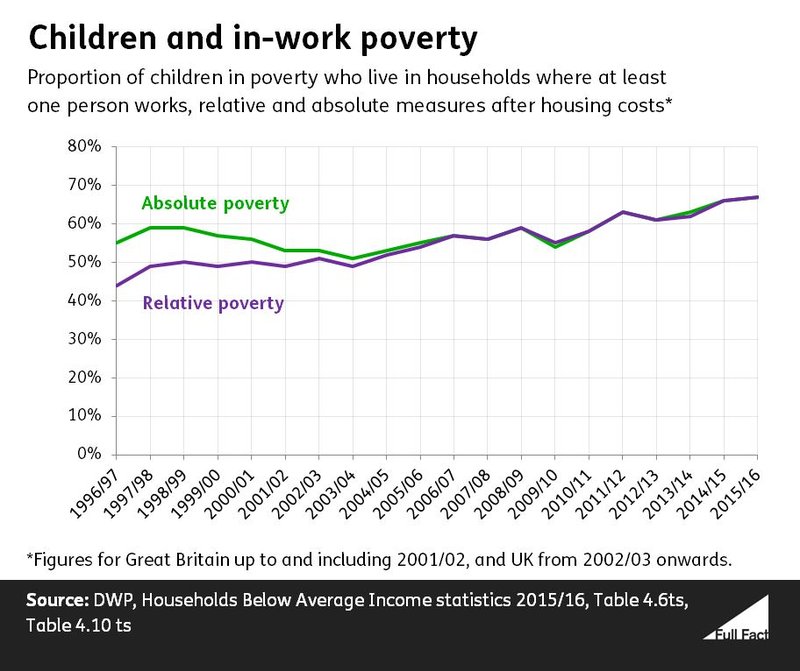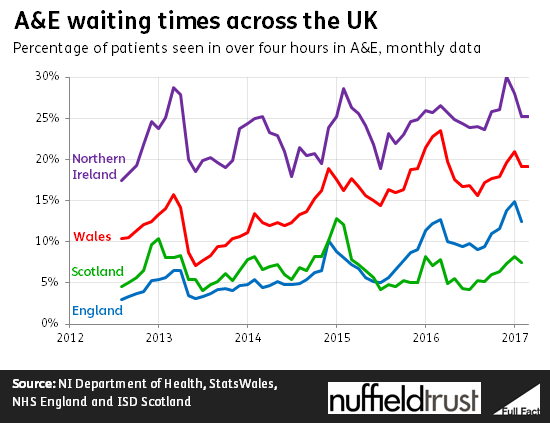SNP manifesto launch, factchecked
We've factchecked five claims from the SNP manifesto launch.
Join 72,953 people who trust us to check the facts
Sign up to get weekly updates on politics, immigration, health and more.
Subscribe to weekly email newsletters from Full Fact for updates on politics, immigration, health and more. Our fact checks are free to read but not to produce, so you will also get occasional emails about fundraising and other ways you can help. You can unsubscribe at any time. For more information about how we use your data see our Privacy Policy.
"Experts [say] … that Tory policy will drive 1 million more children across the UK into poverty. Just think about that. 1 million more children. That means that by 2021, there could be more than 5 million children across the UK, the equivalent to the total population of Scotland, living in poverty in one of the richest countries in the world."
- The Institute for Fiscal Studies, a think tank, projects there will be slightly over a million more children in relative poverty by the end of this parliament than there were at the 2015 general election, and 700,000 more than there are right now.
- It projects there are about 4.4 million children in relative poverty at the moment, and that the number will rise to to 5.1 million by 2021/22, (close to the current population of Scotland). About four million children were in relative poverty around the time of the last election.
- It puts about half this change down to a series of Conservative tax and benefits policies, such as freezing working-age benefits, the two-child limit for tax credits, and introducing Universal Credit.
- Relative poverty is one of several possible measures of poverty, and it expects the rise in absolute poverty to be smaller (we explain the difference in our guide to poverty statistics). 3.5 million children were in absolute poverty at the time of the last general election, according to the IFS, against about 3.9 million now and a projected 4.3 million by 2021/22.
- These aren’t complete predictions about the future: they don't try to account for how people might respond to policy changes by, for example, adapting their working habits.
"One of the biggest scandals in recent years, and it is a scandal, has been the rise of the number living in poverty, despite having a job. 70% of children growing up in poverty live in a household where at least one person is working."
- The figure is correct if you round them to the nearest ten percent.
- 67% of children in poverty live in a household where at least one person is working, according to the Department for Work and Pensions.
- The proportion has been rising in recent years.
- In this case, the figures happen to be the same regardless of whether you look at relative or absolute measures of financial poverty, before or after housing costs.
- We explain the difference in our guide to poverty statistics.

“Our [Scotland’s] accident and emergency is the best performing anywhere in the UK”
- On average Accident and Emergency (A&E) departments in Scotland do perform better against the main waiting time target than A&E departments in the rest of the UK, although they’re still missing targets.
- All four UK countries have a target to admit, transfer or discharge at least 95% of patients within four hours of them attending an A&E department.
- In March 2017 94% of attendances at Scottish A&E services were seen and subsequently admitted, transferred or discharged within 4 hours.
- A&E departments in England were the next best performing, with 90% of patients being admitted, transferred or discharged within four hours in March. This is followed by A&E departments in Wales (81%) and then Northern Ireland (75%).
- The last time Scottish A&E departments met the four hour target across a single month was in July 2016. This is more recently than other UK countries, with English A&E departments last meeting the target in July 2015.
- The four hour target is not the only waiting time target in accident and emergency departments in the UK though.
- In Scotland, Wales and Northern Ireland hospitals are also required to report how many patients wait 12 hours or more from the time they arrive at A&E to the time they leave. Scottish hospitals perform better on this measure as well, with fewer than 1% of patients waiting over 12 hours.
- Hospitals in England don’t have to report these figures though. Instead they report how many patients wait 12 hours or more to be admitted to hospital once an A&E doctor has decided that they need to be.

“But it is important to say that nurses in Scotland get paid more than nurses in England”
- Nurses do get paid less England than in Scotland. After nurses qualify they start on the band 5 NHS pay level, which at the lower end of the scale amounts to £11.31 an hour in England, and £11.47 in Scotland. The difference adds up to just over £300 more a year for a nurse working full time in Scotland. This is without counting any extras for anti-social hours worked or for living in London.
- In fact Scotland’s nurses get paid more than nurses in England, Wales, and Northern Ireland. This is across all pay bands.
- Pay varies across the UK as the different governments have taken different approaches to independent NHS pay review recommendations, according to the Royal College of Nursing. The Scottish government has implemented all pay review recommendations to date.
“Productivity has been growing faster [in Scotland] than the UK and unemployment is lower than the UK average.”
- Productivity is about how efficiently value is created in the economy—in the case of workers, for example, dividing economic output by the number of man-hours that went into making it.
- Scotland’s productivity has been growing faster than the UK’s, although for years it’s been lower than average—so it’s only really catching up.
- Output per hour worked rose by 3.5% in 2015, according to Scottish government statisticians. In the UK as a whole the rise was 0.9%.
- Scottish output per hour is now only a fraction lower than the national average—at 99.9%, although output per job—a different way of measuring productivity—still lags behind, at 97.8%.
- Figures from the Office for National Statistics, calculated slightly differently, show a bigger gap in both cases.
- The unemployment rate in Scotland, for those aged 16 and over, is 4.4%. In the UK as a whole it’s 4.6%. The unemployment rate takes everyone who either has a job or is actively looking for one, and shows what percentage of them are in the latter group.
- But the Scottish employment rate—just how many people are in work as a percentage of the working-age population—is below average. Both these things can be true at the same time because Scotland has a higher rate of people who are ‘economically inactive’ - not in the market for a job, and so not counted as employed or unemployed.